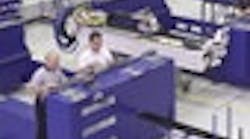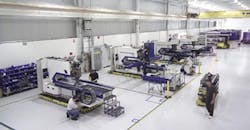When Christian Trumpf acquired Julius Geiger GmbH, a machine shop that produced flexible shafts, a new company—Trumpf—was born in Stuttgart, Germany, in 1923. Soon, the company manufactured motor-driven hand shears for cutting sheet metal, resulting in an entire product range of electric shears. And 25 years after its inception, Trumpf expanded to manufacturing stationary machines. Still headquartered in Germany, the Trumpf Group finished its 2006-’07 fiscal year with worldwide sales of €1.94 billion.
Trumpf Inc., Farmington, Conn., the North American arm of the Trumpf Group, was founded in 1969 and manufactures fabricating equipment and industrial lasers for customers in Canada, Mexico and the U.S. In North America, Trumpf designs and produces precision punching machinery, laser machinery, laser diodes and gas and solid-state laser resonators.
With only 15% of its customer base in the U.S., Trumpf is seeing a change in customer behaviors. “Nowadays, people want choice and personalization of their products, resulting in a lower volume per product and a higher variability within the products produced,” says Burke Doar, VP sales and marketing. “The biggest condition currently driving innovation is currency. As the dollar does not currently carry a significant overseas value, U.S. manufacturers that rely on their overseas counterparts for machine parts, and in some cases, the machine itself, are losing purchasing power.”
What Have You Done for Me Lately?
Because of the global nature of Trumpf’s business, after-sales support is more than an afterthought. “Service is a clear indicator of a company’s commitment to its customers and to long-term growth,” says Kevin Domingue, vice president of customer services. “Trumpf sets itself apart in the market by supporting equipment with a strong and committed customer services and after-sales team.”
In-Sync Assembly
Trumpf’s Synchro Laser Machine Assembly addresses the demand for shorter delivery times and keeps stock levels low.
If a machine problem occurs, in most cases a service technician usually is required to physically attend to the customer. “Tele-diagnostics has become one of our most powerful tools to provide our customers with very fast, real-time and extremely effective support” says Domingue. “It enables our technicians to examine the customer’s machine controls without traveling there. For the customers it means reduced travel expenses and waiting times. For us, it means that we can serve more customers in less time.”
A variety of sensors embedded in each machine allows technicians to diagnose remotely. Trumpf’s TruMark machines, for example, contain more than 240 sensors that gauge everything from electrical and laser power to water and air temperature. Data is transmitted by an analog phone line using the software package PCAnyWhere and through the Internet via WebEx, provided that the customer’s machine has Internet access that is not blocked by a firewall.
“For tele-diagnostics to work, the customer must be at his machine to assist in establishing communication and to ensure personnel safety,” explains Peter Grollman, product manager, TruMark. “Using an analog phone line, the Trumpf service technician dials the number the machine is attached to, the machine connects, and the technician has full access to and control of the machine.”
The exchange between technician and customer is supported through the WebEx platform. Through a graphing monitor system—DAT event logger—screen shots are taken and reviewed for deviations. “The customer has the same view as the technician, and if a problem is detected, the technician can walk the customer through fixing the problem,” says Grollman. Trumpf can fix 90% of problems through tele-diagnostics, he says.
Greater Than the Sum of the Parts and Training
Trumpf promises its customers that it will support its machines with spare parts for 10 years after delivery, after which, parts still are available through a special warehouse in Germany. Parts orders are taken by the administrators in Connecticut. “We usually receive about 100 inquiries an hour,” says Claudio Schutz, director of spare parts in North America. “Orders usually are processed and shipped the same day they are received. Our seven spare-part administrators also look at a customer’s complete order history and refer the customer back to technical customer service for further technical advice. Our customers can rely on a total of 8,000 different parts stored in Connecticut.”
Computer labs, training machines and dedicated training rooms also are available for customers. The training center embraces technology by using special programs duplicating the machine interface on PCs for training purposes, large plasma screens on the machines to make the interface visible to larger audiences and various electronic teaching tools. “These teaching tools include a notepad that can integrate manual drawings into any other system and make them visible and editable on the screen,” says Annette Doyle, manager, Trumpf Training Center. “This is used in our sheet-metal design class. Another popular teaching aid allows our instructors to view all students’ computer screens and help them with problems when they are learning our programming software.”
In the Driver’s Seat
While technology plays an important part in customer services at Trumpf, it doesn’t replace the power of human knowledge. The customer services department has the highest number of long-standing Trumpf members, with many experts having served for more than 30 years. Average length of service in this area is more than six years.
At Trumpf, diverse markets dictate diverse engineering qualifications. “Trumpf hires electrical, mechanical, software, design, quality and manufacturing engineers,” says Sharon Woodrow, manager, human resources. “In total, the company employs approximately 40 engineers at Trumpf North America and approximately 20 at Trumpf Princeton.”
Trumpf also invests in research and development, with more than 7% of annual sales reinvested in R&D this past year. Research laboratories, located in Farmington, Conn., Plymouth, Mich. and Cranbury, N.J., employ nearly 70 people.
Trumpf is divided into five market segments—machine tools, power tools, lasers, electronics and medical systems—that design and build machines for punching, bending, welding, laser marking and laser cutting.
“Trumpf systems use PC-based control and digital networking to connect machines to the material handling and storage systems,” explains Jonathan Chomicz, sales engineer, automation. “The digital networking that goes into Trumpf punching and laser cutting cells enables us to keep track of production plans on both the machine side and the material inventory side. For example, weights and sheet counts of different materials currently in the material storage towers can be tracked along with the status of a specific production plan.”
Trumpf uses sensors to keep track of the physical position of loading and unloading components for punching and laser cutting machines, material handling devices, material carts, elevators and people, explains Chomicz.
“All of these components are used to send and receive digital signals to the machine and network,” he says. “Sensors can range from proximity sensors to laser light-beam sensors for safety and part location and recognition. These innovations in automation allow the user a higher level of clarity with their production levels and requirements. This allows for a higher level of consistency and more time for workers to do secondary tasks and operations because the system is working unmanned. Once a manufacturer understands that by using this methodology they can save money and time, while also cutting down on overall production time, it becomes very easy for them to begin the justification process to purchase this type of equipment.”
In addition, labor costs also are driving innovation. “Only 15-20% of a company’s budget should be dedicated to labor,” reasons Doar. “Anything over 20% requires automation. Trumpf has equipped many of its machines with automation components and the company is constantly looking for innovative ways to help customers save on labor costs.”

Leaders relevant to this article:




